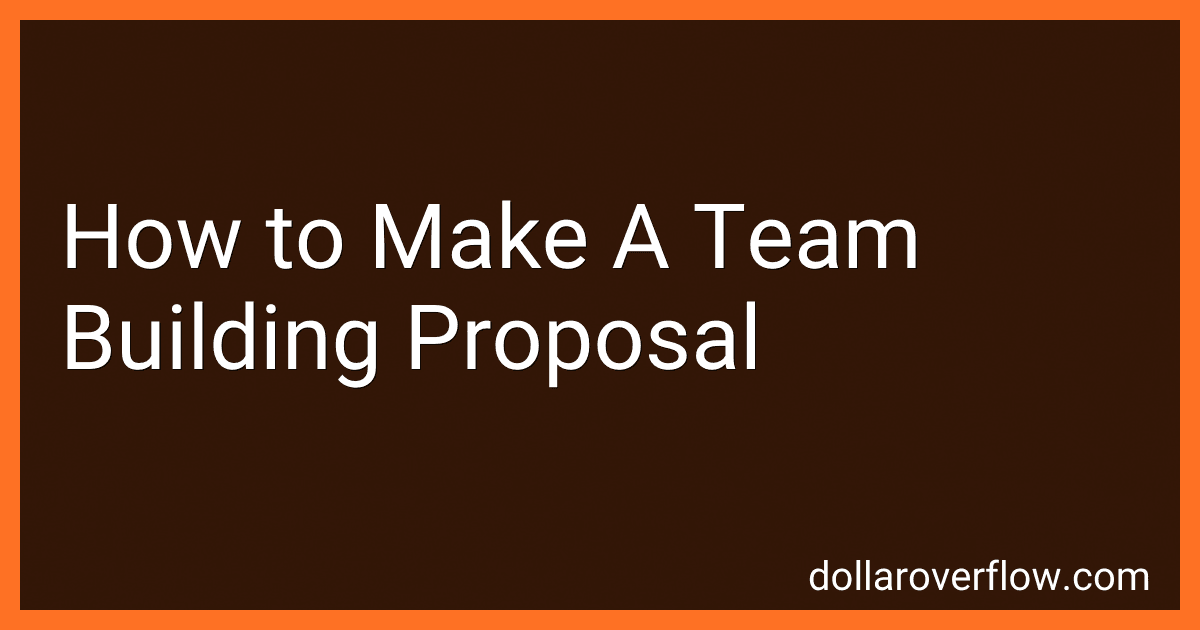Creating a team building proposal involves outlining the objectives, activities, and desired outcomes of the team building event. Start by clearly defining the purpose of the team building activity and explaining how it aligns with the company's goals and values.
Next, outline the specific activities and exercises that will be included in the team building program. Consider the size and composition of the team, as well as any specific challenges or dynamics that need to be addressed.
Describe the desired outcomes of the team building event, such as improved communication, increased collaboration, or enhanced problem-solving skills. Also, include a timeline for the event, as well as any logistical details, such as location, materials needed, and budget considerations.
Finally, be sure to emphasize the benefits of the team building proposal, such as increased employee engagement, higher morale, and improved productivity. Present the proposal in a clear and concise manner, making a strong case for why the team building event is necessary and how it will benefit the team and the organization as a whole.
What are the key components of a successful team building proposal?
- Clear Objective: The proposal should clearly outline the purpose and goals of the team building activity. This could be improving communication, fostering teamwork, enhancing creativity, or any other specific objective.
- Budget and Resources: The proposal should include a detailed budget, outlining all costs associated with the team building activity. It should also specify the resources needed, such as venue, materials, facilitators, etc.
- Timeline: The proposal should include a proposed timeline for the team building activity, including dates, times, and duration of the event.
- Activities and Agenda: The proposal should outline the specific activities and agenda for the team building event. This should include a mix of icebreakers, team building exercises, and discussions tailored to achieve the desired objectives.
- Evaluation and Follow-up: The proposal should include a plan for evaluating the effectiveness of the team building activity. This could include feedback forms, surveys, or other methods of evaluation. It should also specify a plan for follow-up actions to ensure that the outcomes of the team building activity are sustained.
- Alignment with Organizational Goals: The proposal should demonstrate how the team building activity aligns with the overall goals and values of the organization. It should show how the activity will contribute to improving team performance, enhancing employee morale, or achieving other organizational objectives.
- Stakeholder Involvement: The proposal should outline how key stakeholders, such as team leaders, managers, or HR professionals, will be involved in the planning and implementation of the team building activity.
- Customization: The proposal should be tailored to the specific needs and context of the team or organization. It should take into account the size of the team, their level of experience, and any other relevant factors.
How to create a timeline for implementing a team building proposal?
- Set a start date: Decide on the date that you want to launch your team building proposal.
- Identify key milestones: Break down the team building proposal into key milestones, such as developing a proposal, securing budget approval, scheduling team building activities, and evaluating the results.
- Assign responsibilities: Delegate tasks to team members and set deadlines for completion.
- Develop a timeline: Create a timeline that outlines the start and end dates for each milestone, as well as any intermediate deadlines that need to be met.
- Communicate: Keep your team informed about the timeline and any updates or changes that may occur.
- Monitor progress: Regularly review the timeline to ensure that tasks are being completed on schedule and make adjustments as needed.
- Evaluate results: Once the team building activities have been completed, evaluate the results and assess the impact on team performance and collaboration.
- Make adjustments: Use the evaluation to make any necessary adjustments to future team building initiatives.
By following these steps, you can create a timeline for implementing a team building proposal that will help your team work together more effectively and achieve their goals.
How to encourage participation in team building activities in your proposal?
- Highlight the benefits: Clearly outline the benefits of team building activities in your proposal, such as improved communication, increased morale, enhanced collaboration, and better productivity. Emphasize how these activities can help build a stronger, more cohesive team.
- Make it fun and engaging: Include a variety of team building activities that are engaging, interactive, and enjoyable for all team members. Consider incorporating games, challenges, and exercises that promote team bonding and trust.
- Customize activities: Tailor team building activities to suit the interests and preferences of your team members. Consider their personalities, strengths, and areas for development when selecting activities that will resonate with them.
- Foster a positive culture: Create a supportive and inclusive environment where team members feel comfortable participating in team building activities. Encourage open communication, positivity, and respect among team members to create a culture that encourages participation.
- Provide incentives: Offer incentives for participation in team building activities, such as rewards, recognition, or prizes. This can help motivate team members to actively engage in the activities and enhance their overall experience.
- Set clear expectations: Clearly outline the goals and objectives of the team building activities in your proposal. Communicate the importance of participation and explain how it can contribute to the team's success and growth.
- Seek feedback: Encourage team members to provide input and feedback on the team building activities proposed in your proposal. Consider their suggestions and preferences to ensure that the activities are well-received and enjoyable for all participants.
